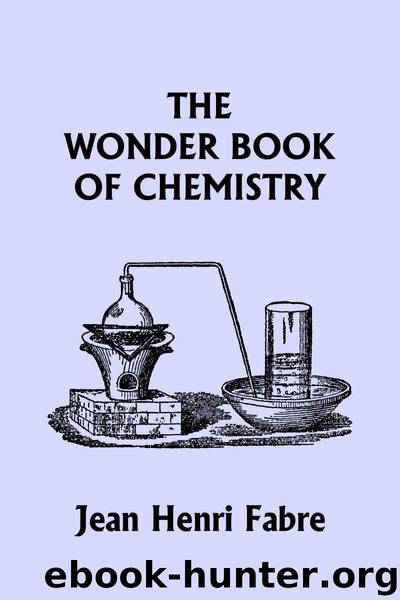The Wonder Book of Chemistry (Yesterday's Classics) by Fabre Jean Henri

Author:Fabre, Jean Henri [Fabre, Jean Henri]
Language: eng
Format: epub
Tags: Nature
ISBN: 9781599152530
Publisher: Yesterday's Classics
Published: 2010-11-09T14:34:10.330000+00:00
CHAPTER XV
Air and Combustion
THE next day the sparrow, quite recovered from its trying ordeal of the day before, did credit to Emile's careful ministration by its vigor and appetite. The supply of oxygen being used up, Uncle Paul had his nephews prepare, under his supervision, a little more of that gas and also some nitrogen. Burning phosphorus under the bell-glass gave nitrogen, and the decomposition of chlorate of potash gave oxygen. The boys fairly beamed with joy at being allowed to take a hand in these momentous operations. All went off according to rule and with great success. It is true that their uncle was there all the time, advising and directing; but it is also true that both Jules and Emile are unusually skilful with their hands. And so their uncle was not afraid to trust them with bell-glass, balloon, tubes, and bottle, for in hands so careful there was no danger of breakage. When the two gases had been collected the lesson began.
"Oxygen is the only breathable gas," said Uncle Paul, "the only one that will sustain animal life, and also the only one that will make fire burn. But its energies are too powerful, as was proved to you yesterday by the sparrow and the candle. These energies must be toned down by the addition of an inactive gas. When a wine is too heady, we weaken it with water to make a drink that will not injure our health. In the same way oxygen, too strong for breathing or for ordinary combustion when pure, must be weakened with nitrogen, an inactive gas. This mixture gives us atmospheric air, in which nitrogen plays the part corresponding to that of water in diluted wine.
"Our burning of phosphorus under the bell-glass showed us that air is composed of two elements, oxygen and nitrogen, the quantity of the latter being four times that of the former. Now we are going to reverse the operation and make air out of the two elements here before us. Here in this bottle is oxygen, and there in that other is nitrogen. By mixing these two gases in the right proportion we ought to get air like that in which we live, air in which a candle will burn calmly and an animal breathe without danger. How are we to proceed in order to obtain this result? Our unduly strong wine,—that is, our oxygen,—must be diluted with a good deal of water, or nitrogen. In fact, we must add to oxygen four times its volume of nitrogen.
"Nothing could be simpler. I fill the bell-glass with water, and then cause a bottleful of oxygen to displace a part of the water. The bottle which is to serve as a common measure for both gases I select at random, taking care, however, that it shall be of moderate size, so that the capacity of the bell-glass may not be exceeded when the two gases are mixed. Here we have, then, our oxygen in the bell-glass; and
Download
This site does not store any files on its server. We only index and link to content provided by other sites. Please contact the content providers to delete copyright contents if any and email us, we'll remove relevant links or contents immediately.
Alchemy and Alchemists by C. J. S. Thompson(3295)
The Elements by Theodore Gray(2852)
The Club by A.L. Brooks(2747)
How to Make Your Own Soap by Sally Hornsey(2741)
Drugs Unlimited by Mike Power(2484)
Wheels of Life by Anodea Judith(1917)
Cracking the Sat French Subject Test, 2013-2014 Edition by The Princeton Review(1766)
Perfume by Jean-Claude Ellena(1735)
The Flavor Matrix by James Briscione(1714)
The Cosmic Machine: The Science That Runs Our Universe and the Story Behind It by Scott Bembenek(1693)
Cracking the LSAT, 2012 Edition by Princeton Review(1690)
MCAT Physics and Math Review by Princeton Review(1567)
1000 Multiple-Choice Questions in Organic Chemistry by Organic Chemistry Academy(1566)
Cracking the SAT Premium Edition with 6 Practice Tests, 2017 by Princeton Review(1480)
The Thing Around Your Neck by Chimamanda Ngozi Adichie(1480)
Handbook of Modern Sensors by Jacob Fraden(1477)
A is for Arsenic: The Poisons of Agatha Christie (Bloomsbury Sigma) by Kathryn Harkup(1455)
Synchrotron Light Sources and Free-Electron Lasers by Eberhard J. Jaeschke Shaukat Khan Jochen R. Schneider & Jerome B. Hastings(1454)
Harry Potter All Books: 8 Books by J.k.rowling(1436)
